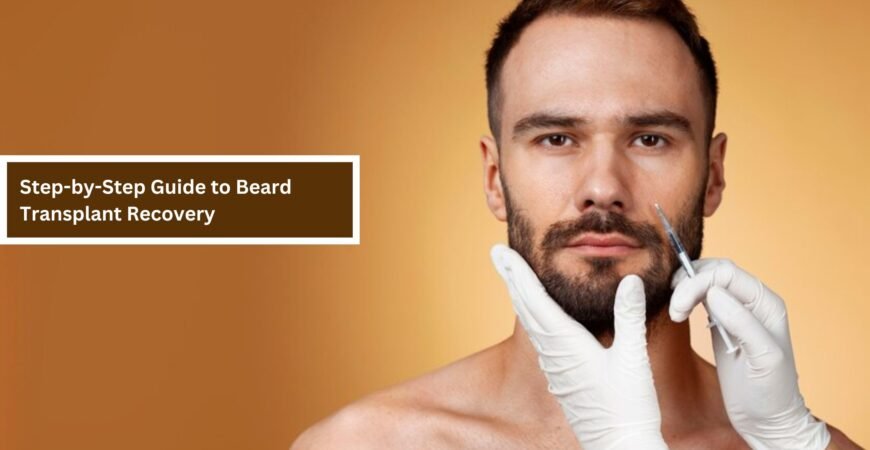A beard transplant can be life-changing for those seeking a fuller, more defined beard. However, the journey doesn’t end with the procedure. Proper recovery is essential for achieving the best outcomes. In this guide, we’ll walk you through the step-by-step process of beard transplant recovery, offering tips to help you confidently guide the healing period.
Immediate Aftercare: The First 48 Hours
The first 48 hours after your beard transplant are critical. You may experience redness, swelling, and tenderness in the donor and recipient areas. These symptoms are typical and should subside within a few days. It is essential to follow your surgeon’s aftercare instructions closely during this period.
Keeping the Transplanted Area Clean
Keeping the transplanted area clean is crucial during the first few days. Your surgeon will advise you to avoid cleaning your face for 24 to 48 hours post-procedure. Afterward, gently wash the area with a mild, non-irritating cleanser. Avoid rubbing or scrubbing the transplanted area to prevent dislodging the grafts.
Reducing Swelling and Discomfort
Sleeping with your head advanced can help decrease swelling. You may also use cold compresses to soothe the affected areas, but follow your surgeon’s guidelines to avoid damaging the delicate grafts. As advised by your surgeon, over-the-counter ache relievers can help manage any discomfort.
Managing Discomfort and Swelling
As you move into the first week after surgery, you might experience some discomfort. Swelling, especially around the cheeks and jawline, is joint but should decrease gradually. Cold compresses can help reduce swelling and relieve pain. However, be cautious and follow your surgeon’s guidelines to avoid damaging the delicate grafts.
Understanding the Scabbing Process
Scabbing around the transplanted follicles is normal and usually falls off within a week to ten days. It’s crucial not to pick at these scabs, as doing so could dislodge the grafts and affect the outcome of your beard transplant. Allow the scabs to drop off naturally to ensure proper healing.
The Shedding Phase: Understanding Shock Loss
Around two to three weeks after your beard transplant, you may notice the transplanted hairs begin to fall out. This is known as “shock loss” and is a normal part of recovery. While it might be alarming, shedding indicates that the follicles are settling in and preparing to grow new hair.
Preparing for New Hair Growth
The hair that falls out during the shedding phase will be replaced by new, stronger hair in the coming months. Patience is essential during this period, as it can take several months for the full results of the transplant to become visible. Understanding this approach can help manage your anticipations and reduce anxiety about the initial shedding.
Long-Term Care: Supporting Healthy Growth
New hair growth should become noticeable as you enter the third-month post-transplant. This is the time to focus on maintaining the health and development of your new beard. Use gentle, non-irritating skincare products to avoid irritation or damage to the sensitive area.
Maintaining a Healthy Diet
Incorporating a nutritious diet rich in vitamins and minerals, especially those that support hair growth, can also promote the strength and quality of your new beard. Nutrients like biotin, zinc, and vitamins A and C are particularly beneficial for hair health.
Moisturizing the Skin
Regularly moistening the skin under your beard can prevent dryness and flakiness, which are expected as your beard grows. Your surgeon may recommend specific products or treatments to improve the health and formation of your beard over time.
Patience: The Key to Final Results
The full results of your beard transplant can take up to a year to become fully apparent. During this time, patience is vital. The initial few months might feel slow, but as the new hair follicles take root and grow, you’ll gradually see the fuller, thicker beard you’ve been waiting for.
Considering Follow-Up Treatments
Some patients may also require a follow-up session to achieve the desired density or address any areas that didn’t respond as expected to the initial transplant. Your surgeon will observe your improvement and advise if other treatments are necessary.
Conclusion
Recovering from a beard transplant requires careful attention and patience. Following your surgeon’s guidelines, managing your expectations, and maintaining a healthy routine can ensure a smooth recovery and achieve the best possible results. While the process may take time, the outcome—a fuller, more defined beard—is well worth the effort. With proper care and patience, you’ll soon enjoy the confidence and satisfaction that comes with your new look.












